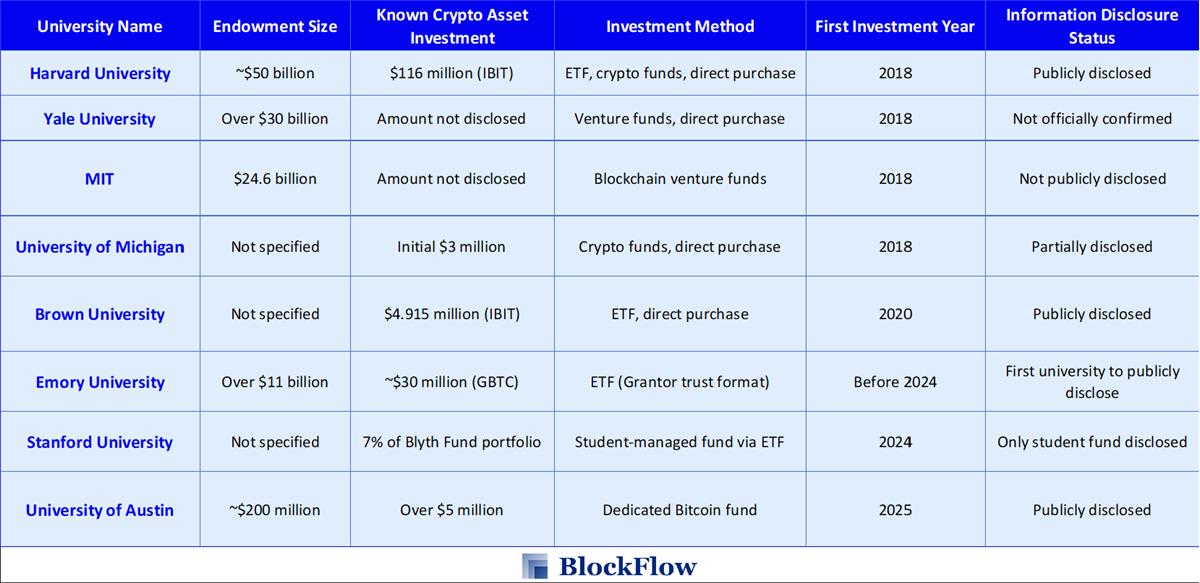Universities Have Become the 'Powerful Cliques' of the Crypto World.
Written By Yanz, Liam Huang
In August 2025, Bitcoin broke past the $120,000 mark, propelling the once "niche asset" firmly into the mainstream financial arena. This rally wasn’t merely fueled by Wall Street hedge funds but also by the most cautious and calculated money managers from Ivy League institutions.
On August 9, the U.S. SEC unveiled its 13F filings, highlighting a noteworthy detail. Harvard University's endowment fund, valued at approximately $53.2 billion, held $116 million in Bitcoin ETFs (IBIT) during Q2 2025.
This positioned Bitcoin ETFs as Harvard's fifth-largest portfolio holding, trailing only Microsoft, Amazon, Booking Holdings, and Meta, while surpassing its investments in Alphabet, Google's parent company, and Nvidia.
Harvard isn't alone in this trend. Brown University, Emory University, and the University of Texas at Austin have also publicly disclosed their cryptocurrency holdings.

The embrace of cryptocurrencies by these "hoarders" within ivory towers is not a sudden impulse but rather the culmination of years of strategic planning coming to light.
Elite universities’ capital, talent, and technology have long been deeply rooted in the crypto industry.
This time, however, they are stepping out of the shadows and into the spotlight.
Investing in Crypto Amid the Burst of a Bubble
2018 marked the darkest hour for the cryptocurrency industry.
With the collapse of the ICO bubble, the global market capitalization of crypto assets evaporated by over $630 billion, plummeting to less than $200 billion. Bitcoin fell to $3,000, Ethereum to $80, retail investors fled en masse, and cryptocurrencies were labeled as "Ponzi schemes." Even Facebook announced a ban on crypto-related advertisements.
During this period of widespread avoidance, Yale University's endowment fund made a decision that defied convention.
Under the leadership of legendary investor David Swensen, Yale teamed up with Harvard, Stanford, and other elite institutions in October 2018 to invest in Paradigm's inaugural $450 million crypto fund. Paradigm was founded by Coinbase co-founder Fred Ehrsam and former Sequoia Capital partner Matt Huang. Yale also participated in a16z's first crypto fund, totaling $400 million.
Looking back, these investments made during the industry's low point not only shaped the trajectories of Paradigm and a16z but also accelerated the historical progression of the crypto sector.
Paradigm initially planned to allocate 60% of its funds to crypto assets and 40% to equity in crypto startups. However, after securing funding, Paradigm took a bold step. Through its investment in trading platform Tagomi, it heavily purchased Bitcoin and Ethereum during the dip, with Bitcoin's acquisition cost averaging around $4,000. Just months later, in the first half of 2019, Bitcoin's price surged past $10,000.
For university endowment funds, directly purchasing Bitcoin was not feasible at the time, nor were there compliant ETF products available. Having Paradigm hold crypto assets on their behalf was a "backdoor entry" strategy. Even if losses occurred, the fund could mitigate risks in terms of compliance and accountability.
How Matt Huang managed to convince Yale's fund to invest in a newly established crypto fund remains an intriguing mystery.
Although Matt Huang's mother, Marina Chen, was a professor in Yale University's computer science department, there is no evidence suggesting Marina Chen influenced Yale's decision to invest in Paradigm.
A glimpse into Matt Huang's persuasion tactics can be found in his 2020 article, Preaching Bitcoin to Enlightened Skeptics.

Matt Huang believes that bubbles are not flaws but necessary steps for Bitcoin to achieve broader acceptance. Each bubble increases Bitcoin's recognition and adoption.
While Bitcoin may not challenge the U.S. dollar as a medium of exchange in the short term, it is poised to eventually stand alongside gold as a hedging tool in investment portfolios. Institutional investors are likely to hold Bitcoin, and central banks may even adopt it as a reserve asset in the future.

For the crypto industry, Paradigm has been more than just a capital provider; it has played a pivotal role as a builder.
In April 2019, Paradigm led the seed round with a $1 million investment in Uniswap. At that time, Uniswap had not yet established itself as a company, and its sole developer was founder Hayden Adams. Adams, a mechanical engineer laid off by Siemens, had only started learning Solidity in 2017.
Paradigm's involvement extended beyond financial support. Dan Robinson, a member of its research team, actively participated in Uniswap's Discord community, providing daily assistance with liquidity challenges and smart contract troubleshooting. Their collaboration led to the creation of the AMM model, which later ignited the DeFi summer.
Paradigm's portfolio boasts numerous star projects, including StarkWare, Mina, Uniswap, Compound, MakerDAO, Yield, Optimism, Amber, Fireblocks, Synthetix, Opyn, TaxBit, BlockFi, Chainalysis, Gitcoin, Lido, dYdX, and more.
Another early crypto fund invested by Yale, a16z crypto, has similarly shaped the industry's development. It has backed prominent projects like Coinbase, Solana, Aptos, Avalanche, and Arweave. Beyond investments, a16z has leveraged its influence in public policy to actively drive the industry's growth. The firm donated tens of millions of dollars to the pro-crypto Super PAC Fairshake and supported Trump’s election campaign, aiming to secure a more favorable crypto policy environment.
The foundation for this transformative impact on the crypto sector dates back to late 2018, when legendary investor David Swensen made a groundbreaking decision.

As Yale's highest-paid staff member, Swensen managed the university's multi-billion-dollar endowment fund for 34 years, growing its size from $1 billion to $31.2 billion while delivering an average annual return of nearly 17%.
His "Yale Model" became the gold standard for university endowment funds globally. Today, many fund managers at top institutions such as Princeton, Stanford, MIT, and UPenn are his former employees, collectively known as the "Yale School."
Yale's entry into crypto triggered a chain reaction. Harvard, Stanford, MIT, and other Ivy League schools followed suit. In late 2018, The Information reported that Harvard University, Stanford University, Dartmouth College, MIT, and the University of North Carolina had all invested in at least one crypto fund through their endowment programs.
Yale's 2018 investment was not merely a lifeline during the industry's winter; it was also a high-profile vote of confidence in the future of the crypto sector.
Crypto Cliques within Elite Universities
Beyond capital and endorsements, the world's top universities exert an even deeper influence on the crypto industry through their people.
Where there are people, there are cliques. In the crypto world, many leaders and key players originate from elite universities, forming invisible yet powerful university cliques.
In the Chinese-speaking world, the Tsinghua clique undoubtedly holds the most influence. Li Lin, founder of Huobi, graduated from Tsinghua University's Department of Automation. The core team behind the high-performance Layer 1 blockchain Conflux is from Tsinghua's Yao Class. Similarly, Gu Ronghui, the CEO and co-founder of CertiK, a leading blockchain security company, is a Tsinghua alumnus.
Tron's founder Justin Sun and Bitmain's founder Jihan Wu are both graduates of Peking University.
Zhejiang University's alumni projects span across Web3 applications, ranging from NFT trading platform Magic Eden to NFT data platform NFTGo, and from the viral blockchain game Stepn to hardware wallet Keystone. These projects cover multiple consumer-facing application tracks.
In the U.S., elite university backgrounds are almost a standard among crypto founders. The Stanford clique, bolstered by its proximity to Silicon Valley, wields tremendous influence in the crypto industry, producing founders of star projects like OpenSea, Alchemy, Filecoin, and Story, as well as industry leaders like Solana Foundation Chair Lily Liu.
In 2019, Stanford University's blockchain conference featured a star-studded roster of sponsors, including Ethereum, Cosmos, Polychain, and other prominent projects and organizations. The event rivaled many large-scale crypto conferences in terms of influence.

The MIT clique excels in technical research. MIT's Digital Currency Initiative (DCI) team contributed to the development of Zcash, which was selected by MIT as one of the world's ten breakthrough technologies in 2018. Zero-knowledge proof (ZK), a milestone in cryptography, was first proposed in the 1980s by MIT researchers.
MIT professor and Turing Award laureate Silvio Micali took this one step further by founding the high-performance blockchain Algorand in 2018.
MIT's alumni roster reads like a "Who's Who" of crypto stars, including Paradigm founder Matt Huang, MicroStrategy founder Michael Saylor, StarkWare co-founder Uri Kolodny, Litecoin founder Charlie Lee, and FTX founder Sam Bankman-Fried (SBF).

The University of California, Berkeley (UCB) is highly active in entrepreneurship and incubation.
In January 2019, Berkeley established the blockchain startup accelerator Berkeley Blockchain Xcelerator, operated by Berkeley Haas School of Business, Berkeley Engineering's Sutardja Center for Entrepreneurship & Technology (SCET), and Berkeley Blockchain.
The accelerator incubates early-stage crypto projects annually and has accelerated over 100 companies to date. Computer Science professor Song Xiaodong even founded the privacy-oriented blockchain Oasis Network. Other notable UCB projects include Galxe, Osmosis, Sei Network, Opyn, Ampleforth, and Kadena.
The Princeton clique wields significant influence in the investment domain.
In 2022, four alumni from Princeton's Class of 1987, including Ethereum co-founder Joseph Lubin, Pantera Capital founder Daniel Morehead, Galaxy Digital founder Michael Novogratz, and Fortress Investment Group's Peter Briger, jointly donated $20 million to their alma mater to launch a blockchain research initiative.
When Morehead founded Pantera, he received early support from Briger and Novogratz. Today, Pantera has grown into a top-tier crypto fund managing over $5 billion in assets.
In an industry that emphasizes "Don't Trust, Verify," interpersonal trust becomes all the more precious. Alumni relationships serve as natural trust bridges: founders are more inclined to hire alumni, and investors are more willing to fund alumni, forming an invisible barrier of clique culture.
When Li Lin founded Huobi, he recruited classmates Lan Jianzhong and Zhu Jiawei, with over half of the senior executives being Tsinghua alumni. Former CEO Qi Ye and CFO Zhang Li also graduated from Tsinghua. Similarly, Jihan Wu heavily relied on fellow Peking University alumni to assist him at Bitmain.
Today, blockchain courses have become standard offerings at major universities, while student blockchain clubs and alumni networks weave invisible webs of talent and capital. Stanford's CBR conference, Berkeley's Xcelerator, and MIT's DCI hackathons are continuously injecting fresh blood into the crypto world.
Universities are no longer just the industry's early investors. They have transformed into martial arts sects of the crypto landscape, shaping its future through talent and innovation.
 PEPE0.00 0.51%
PEPE0.00 0.51%
 TON1.55 2.34%
TON1.55 2.34%
 BNB858.94 -0.51%
BNB858.94 -0.51%
 SOL138.13 -0.28%
SOL138.13 -0.28%
 XRP2.18 -3.16%
XRP2.18 -3.16%
 DOGE0.15 -0.93%
DOGE0.15 -0.93%
 TRX0.27 0.51%
TRX0.27 0.51%
 ETH2931.24 -0.19%
ETH2931.24 -0.19%
 BTC87266.97 -1.17%
BTC87266.97 -1.17%
 SUI1.52 -2.29%
SUI1.52 -2.29%












